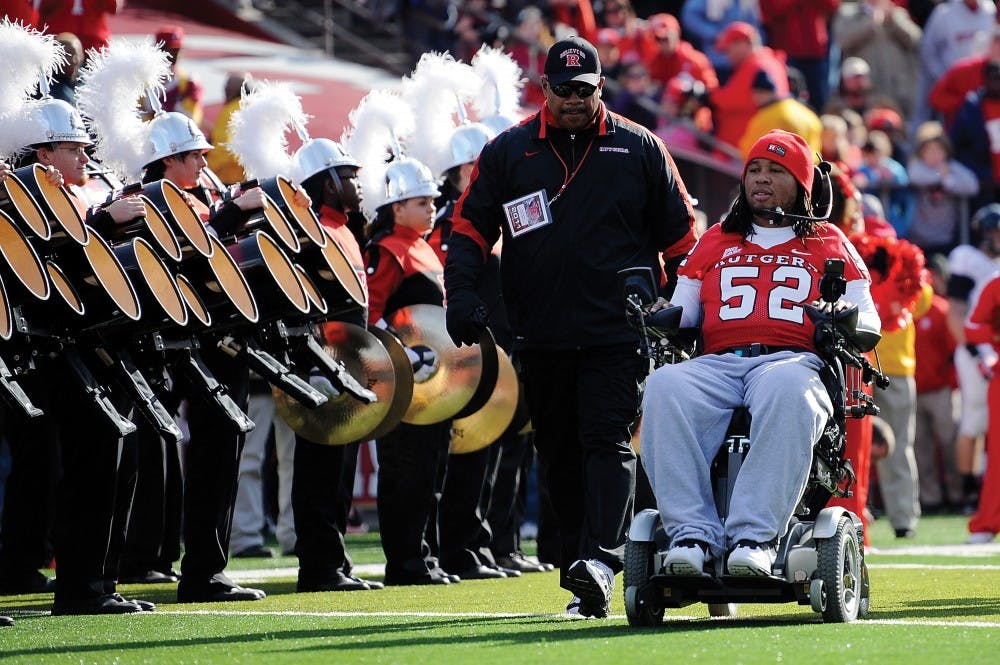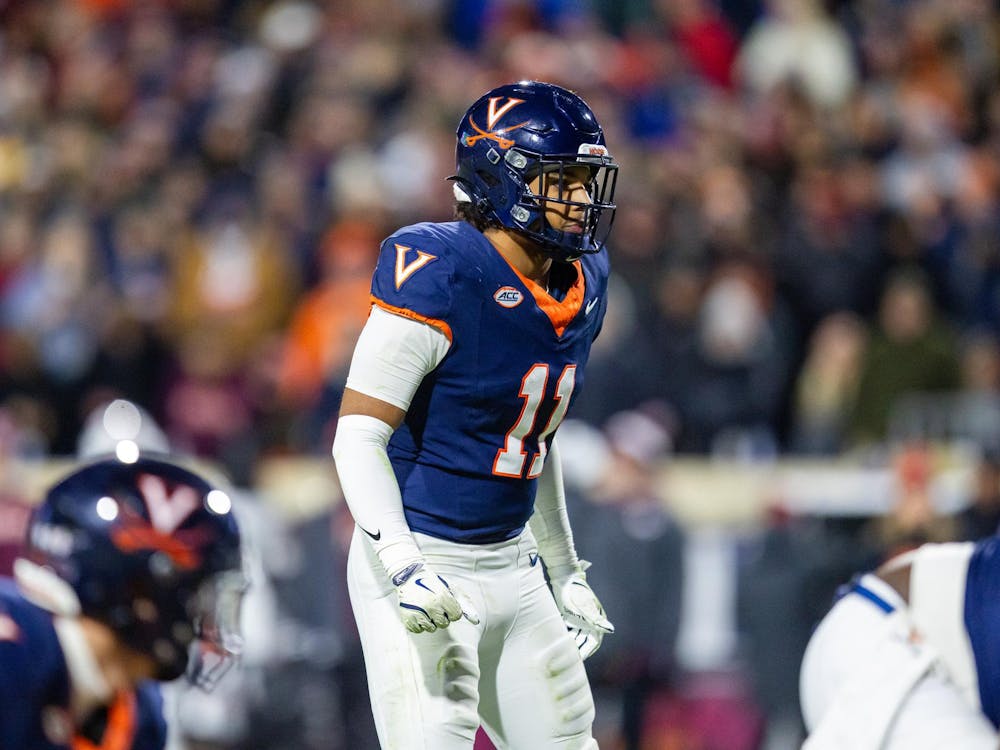During Virginia’s abysmal 56-20 defeat to Georgia Tech Sept. 15, many fans witnessed a phenomenon they had likely never seen before. On two distinct occasions in the first half, Yellow Jackets quarterback Tevin Washington barreled to the Cavalier one-yard line before having his helmet dislodged. A new rule implemented by the NCAA this year meant the redshirt senior was forced to sit out the subsequent play each time — despite suffering no apparent discomfort on either play.
On the surface, Washington’s mandated timeouts amounted to needless disruptions of the game born from an overcautious NCAA rule. These stoppages in play, however, embody the apprehension about head trauma that has gripped the football world in recent years. And although the controversy brewing in the NFL about the concussion-induced deterioration of its former players has taken the spotlight, the NCAA faces a similar predicament: reconciling the violence of football with the necessity of protecting players against the alarming consequences of extensive head trauma.
“We know enough to make us really scared,” said Dr. Jennifer Reesman, a pediatric neuropsychologist at the Kennedy Krieger Institute, a neurology research and education center. “But we don’t know enough to guide us in terms of what we should be doing.”
Extensive research in recent years has shed light on head trauma in football, an issue largely ignored for the first century of the sport’s existence. In an email to The Cavalier Daily, Drs. Jeffery Barth, Donna Broshek and Jason Freeman — the director and associate directors, respectively, of the University Brain Injury and Sports Concussion Institute (BISC) — said the “jury is still out” on a causal link between concussions and Chronic Traumatic Encephalopathy (CTE). CTE is a progressive neurological deficiency that gradually inhibits the “executive functions” of the brain responsible for concentration, memory and multi-tasking. The disease often leads to severe dementia.
Barth indicated that those who incur head injuries in football from helmet-to-helmet hits or high-impact collisions are more susceptible to CTE, depending on the frequency of concussions and quality of post-trauma clinical evaluation. A study led by Dr. Ann McKee estimated that 17 percent of those suffering from repetitive concussions or mild brain trauma eventually contract CTE.
“There are multiple risk factors that need to be considered in the development of CTE,” the BISC representatives said. “Frequency of concussion and number of concussive and subconcussive blows may increase the risk for neurodegenerative disease later in life.”
NCAA athletes may be especially at risk of developing potentially debilitating head trauma from in-game action given their youth. According to Reesman, the developing brain, which she classifies roughly as belonging to any person less than 30 years old, “appears to be more vulnerable and can take longer to recover.”
Perturbed by the growing chorus of scientists correlating concussions sustained in football with chronic brain illness, the NCAA has recently redoubled its efforts to both illuminate the issue of concussions and mitigate the risk of head injuries occurring.
Spurred by the horrific paralysis of Rutgers defensive lineman Eric Legrand on a kickoff in 2010, the NCAA Rules Committee headed by Moravian College Athletic Director Scot Dapp has focused largely on protecting players on special teams plays. Following the lead of the NFL, the committee in February proposed a rule to move kickoffs to the 35-yard line and award possession to receiving teams at the 25-yard line for touchbacks — a move that both Dapp and the BISC said could significantly limit concussions and serious injuries by reducing the frequency of kickoff returns.
“Because special teams players often attain a high rate of speed prior to tackle/impact, there is a greater potential risk of acceleration-deceleration concussive injury,” the BISC representatives said.
In contrast, the “helmet rule” on display in the Virginia-Georgia Tech game aims to improve the identification of symptoms rather than a reduction of actual injury. Players who lose their helmets will now automatically undergo a brief examination for concussion symptoms, which the NCAA hopes will preclude players from masking head injuries to return to action.
“Requiring a player to sit out after an impact that results in loss of his helmet will enable the medical staff to assess the athlete for any signs of concussion,” the BISC representatives said. “As a result, there may be improved early identification of concussion, which will improve safety and clinical management of concussions.”
College football’s governing body and many schools have also embarked on a series of what Reesman calls “really important longitudinal studies” researching concussions incurred during athletic pursuits. For instance, the NCAA Injury Surveillance Program announced last week that the concussion rate has stabilized from 2004-12 after a period of steady escalation during the 20 preceding years. The results indicate improved examination and treatment techniques instituted in the 2000s have driven down the frequency of concussions. In addition, Virginia Tech conducted a frequently referenced study in 2011 that approximated the safety ratings of different brands of helmets.
But for all the encouraging strides in concussion identification and prevention in recent years, head injuries remain a staple of a sport that is gladiatorial by nature. Concussion rates plateaued but did not fall drastically in the last decade, and the broken neck suffered by Tulane safety Devon Walker on a helmet-to-helmet collision earlier this season testifies to the continued danger of playing football. Reesman, for one, blames a lack of definitive empirical evidence to support a clear plan of action to lessen the sport’s inherent risk. Until we understand the full implications of the link between football, concussions and CTE, she argues, we can only grasp at solutions.
“We’re at a point where we know enough to say there is a significant risk out there, let’s be doing something proactively,” Reesman said. “But we have very little data to guide us in what we should be doing.”
Another explanation for the stubborn prevalence of head trauma in football involves the notion that, in spite of NCAA rules, players cannot resist using their helmets as weapons during the game. Though most scientists agree that modern helmets offer decent protection against impact to the head, the headgear is not designed to weather the high-speed collisions arising from head-to-head contact.
“The primary function of helmets is to protect against skull fracture and that is why they were initially introduced into the game,” the BISC representatives said. “While modern helmet design may mitigate some aspects of concussion-inducing forces being transmitted to the brain, helmets rarely provide protection against acceleration-deceleration or rotational forces on the brain.”
Some observers have even advocated the elimination of helmets, pointing to the lack of a similar concussion-induced hoopla surrounding rugby. They contend that the enhanced protection actually encourages players to engage in high-risk, reckless play by reassuring them of their safety.
But Reesman countered that the increasing cases of CTE in retired players may result from improved diagnosis rather than from an uptick in concussions because of helmet usage. And a 2008 study by Rhodes University in South Africa concluded that rugby players do, in fact, suffer from many of the concussion-related mental ailments that plague football.
Ultimately, despite the NCAA’s tremendous recent progress in combating head trauma, the implications of recent discoveries remain murky. It is still unclear whether the NCAA or any football league can find a happy medium between preserving Americans’ darling sport and minimizing the risk of concussions and CTE. Nevertheless, Reesman remains optimistic that we are heading in an encouraging direction.
“I think time will tell,” Reesman said. “I think there’s some promising work out there.”







